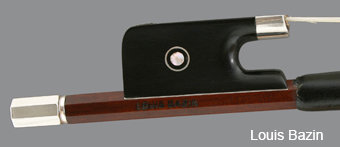Click photos to see our bows for sale arranged by maker.
This article is designed to help you understand the very complex subject of French violin bows from around 1880 until the 1980s. Unlike violins which are normally either made by a particular maker and labelled or branded as such or are workshop instruments which are also often labelled as being “of the atelier” or “finished and sold by”, bows are much more complicated.
A very large percentage of bows made by a particular maker will carry the brand of someone else. Sometimes this brand will be of another bow maker but more often than not it will be a violin maker, a dealer or sometimes a fictitious model name. This situation may lead you to think that once you know who the bow maker supplied you would consequently know which brands would appear on his bows! Alas it is not that easy as several bow makers would supply the same buyer! Perhaps before we go further an example might help:

One of the best and most prolific makers was Charles Louis Bazin. He made bows for at least 16 violin makers including Paul Beuscher, Albert Deblaye and Roger & Max Millant. It just so happens that Morizot Frères also made bows for the above three violin makers. In each case the violin making firm would purchase the bows without stamps and then apply their own: this is why there is so much confusion as to actual provenance. As you can see from the above example, a bow stamped Paul Beuscher could have been made by either C.L.Bazin or Morizot Frères or one of the lesser known makers all of whom were supplying bows at the time.
The actual maker of the bow is ascertained by careful examination of certain features, such as the shape of the head, length of stick, dimensions of the frog and then finer details which help to establish as to whether the bow is a workshop bow made by assistants or made by the master himself. These include such details as the type of joint used in the heel plate (is it bent from one piece or is it joined at the angle), the number of pins in the heel plate and in the underslide. The diameter of pearl eyes and rings, the number and dimensions of the winder rings, type of thread used and so on. As you can see it takes considerable knowledge, comprehensive reference books and a feel for the bows of the period.
Which bow should you buy?
The old French mid priced bows can be very good value for money and are usually genuine. No one is going to bother to fake a J.T.L. bow or Louis Morizot for example. For most people the confusion arises because of the stamp. In my experience it is the higher price range bows that can sometimes be questionable and are more likely to be subject to either faking or sometimes just a very good modern copy. Makers such as Vigneron, Thomassin, Fetique and Peccatte have all been treated this way.
Jerome Thibouville-Lamy workshops
The least expensive bows that can be considered as from a known source or maker are the J.T.L. bows. The Jerome Thibouville-Lamy workshops had their own bow makers who produced a range of qualities, they are good intermediate bows signed with a variety of stamps such as Grandini, Buthod, Duchene, Lupot, Vidoudez, J.Lamy and several others. They also bought many bows from the Bazin workshops.
With all the dedicated bow makers, you find both workshop bows (made by the maker’s assistants) and you have bows made in part or entirely by the maker himself. The following, in no particular order, are some of the well-known families in French Violin Bow making. Almost all also made bows for violas, cellos and double basses as well as for the violin.
François Lotte, born 1889 died 1970
François Lotte was the father, with Roger François Lotte carrying on his father’s work, he served his apprentiship with Bazin where we find him on the list of workers in 1921. All the fine quality bow makers sold their bows stamped with their name or model name as being their best quality but they also sold bows unstamped to dealers who would then apply their own stamp: this is one of the reasons there is so much confusion as to who actually made a particular bow. François Lotte worked for, amongst others, Apparut & Hilaire, Paul Serdet, Marcel Vatelot and Roger & Max Millant. Therefore any of these names can appear on a François Lotte bow or his own name, François Lotte.
Roger François Lotte, born 1922 died 1989.He was the the son of François Lotte. He made bows for: George Deblaye, Dupuy, Léon Mougenot and also Roger & Max Millant amongst others. His best bows made entirely by himself are stamped with his name: Roger François Lotte and sometimes Roger Lotte. Bows by both the father and the son are increasing in value quite rapidly. At the time of writing this article in 2009 the Lotte bows have increased in value by well over 100% in five years.
In a similar price range and quality are the Marc Laberte bows. Marc Laberte started producing excellent bows from around the 1920s until 1960 but they go much further back, the firm was founded in 1780, Marc Laberte was born in 1880, the son of Auguste Laberte and Gabrielle Fournier. The best bows were branded Marc Laberte or Laberte and also a workshop model branded V.J.Ferelli. The silver mounted examples are very good bows and well worth considering. The Laberte style of bow has a fairly long frog with a deep throat and a fairly round style of head. Marc Laberte died in March 1963. His workshops produced many excellent violins as well as the very good bows which carry his brands.